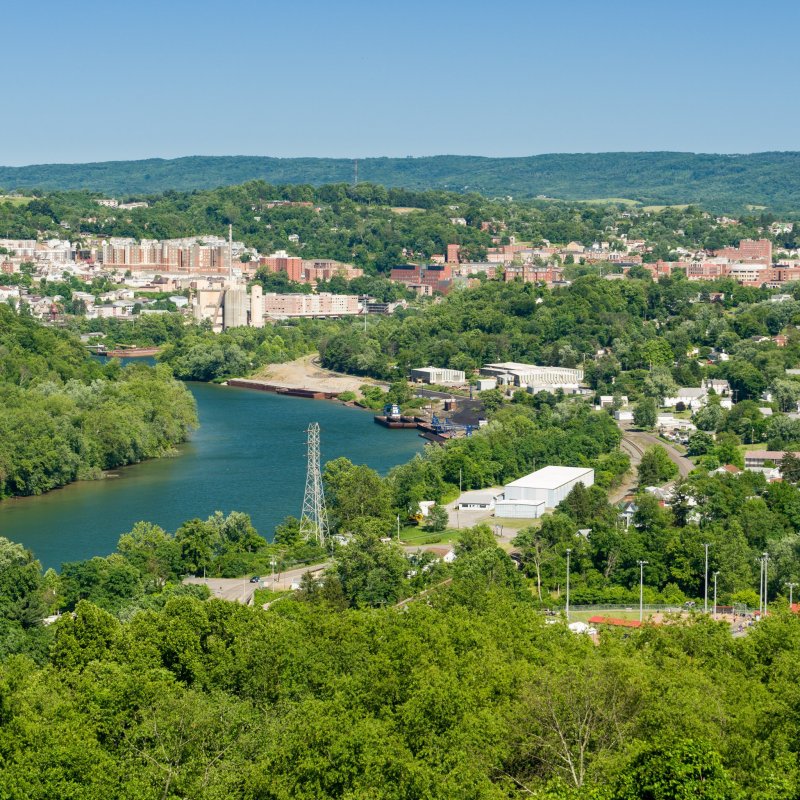
The Potomac Highlands region of West Virginia is probably the area John Denver was referring to in his song “Take Me Home, Country Roads.” Rugged, mountainous terrain isolates this area, and the country roads separating the small towns are perfect for a road trip.
Videos by TravelAwaits
West Virginia is beautiful all year round, but it’s especially spectacular in the fall, when the leaves change colors.
This West Virginia road trip will take you approximately 200 miles through the Mountain State on a drive you won’t soon forget.
Morgantown
Our trip begins in Morgantown, home of West Virginia University. Check out The Art Museum of WVU, the West Virginia Botanic Garden, and the Core Arboretum. All are free to the public.
You could either spend a few days here and see several of the following scenic areas on day trips or stay a day or two in Morgantown before heading south.

Monongahela National Forest
Leaving Morgantown, you will head south on West Virginia Route 7 for approximately 60 miles to Monongahela National Forest. A vast forest of more than 900,000 acres, it boasts 19 campgrounds, 700 miles of hiking trails, three swimming beaches, and 600 miles or more of coldwater streams for fishing.
The rest of this road trip will be almost entirely in the Monongahela National Forest — that’s how extensive it is!

Blackwater Falls State Park
Our first stop in the Monongahela National Forest is Blackwater Falls State Park. If you are looking for picturesque waterfalls, the 1,688-acre state park slightly west of Davis has an abundance of cascades for your viewing pleasure. Blackwater Falls is the crown jewel of them all, where the Blackwater River makes a six-story plunge into the gorge below. A staircase leads to the base of the falls, but there is also an easier path that’s accessible to all.
If you enjoy hiking, the park features a network of trails and overlooks offering scenic views of both the upper and lower gorges.
If you’re only planning on viewing Blackwater Falls, you’ll only be here an hour or two. If you’d like to hike to any of the overlooks, plan on spending a half day or longer in the park

Canaan Valley Resort State Park
Follow West Virginia Route 32 south for 15 miles, and then make a right turn at Main Park Road to get to the Canaan Valley Resort State Park. With over 3,000 feet of elevation, the valley enjoys cooler summer temperatures and an abundance of snow in the winter.
Great for skiing, Canaan Valley provides incredibly gorgeous views of unspoiled terrain full of misty evergreen forests, lush meadows, and the second-largest inland wetland in America. The area is a photographer’s dream and is home to all kinds of critters, including wild turkeys, black bears, coyotes, and very tame deer.
Ride the chairlift to the summit of Weiss Knob for a phenomenal panoramic view of the highlands. Allow several hours to drive through the park and ride the chairlift.

Dolly Sods Wilderness
Next, follow Laneville Road and Forest Road 75 to the Dolly Sods Wilderness. If you enjoy bird-watching, this will be your favorite stop on this road trip. The Allegheny Front creates a natural airborne highway for migrating birds, especially hawks.
This area’s elevation ranges from 2,600 to more than 4,000 feet and has tundra-like terrain similar to that of Northern Canada. Destroyed by the harvesting of trees, fire, and erosion, much of the topsoil was stripped away. But vegetation still survives in the wildflower meadows, cranberry bogs, dwarf red spruce stands, and berry thickets.
Plan for an hour or two of bird-watching at this site.
Elkins
You will have to backtrack a bit to get to West Virginia Route 32. Head south, and then when you reach Harman, head west on U.S. Route 33. You will travel through the Bear Heaven Recreation Area — watch for the black bears that populate this area.
From there, take the mountain road known as Stuart Memorial Drive through some of the area’s most sensational alpine scenery. Follow the signs for the Stuart Recreation Area until you get to the Bickle Knob Picnic Area. You will find a four-story lookout tower that provides unforgettable views from the observation deck. You’ll see the Cheat Mountain and the the highest point in West Virginia, Spruce Knob. You can also see the town of Elkins and the Tygart Valley River.
The headquarters for Monongahela National Forest, Elkins is a small town of around 7,000 people but offers as much history and culture as much larger cities.
Be sure to stop at the Elkins Depot Welcome Center. It is a train depot and is still used by the Durbin & Greenbrier Valley Railroad, which offers historic train rides through the West Virginia countryside. The welcome center also houses a free exhibit, The Town that Industry Built.
A block away from the welcome center is the Appalachian Forest Discovery Center. Located in an old mill, the second-floor museum houses rotating exhibits and a permanent display entitled Discovering the Appalachian Forest. The center is free for visitors.
Cheat Summit Fort is also located in Elkins and was built during the Civil War to protect the Baltimore and Ohio Railroad. It was the first place a telegraph was used during the war. Access is dependent on weather conditions.
You could easily spend a full day in Elkins.

Gaudineer Scenic Area
From Elkins, head south on U.S. Route 250 for 35 miles, and then turn left onto Forest Road 27 to get to the Gaudineer Scenic Area, where you’ll find 140 acres of virgin forest. These 100-foot-tall trees are estimated to be three centuries old. This is an excellent spot for leaf-peeping in the fall.
If you’re an angler, you will enjoy the Shavers Fork River on the area’s western border. It is stocked with plenty of trout.
You could spend anywhere from a few minutes here viewing the trees to several hours fishing.

Snowshoe Mountain
Follow West Virginia Route 92 south and West Virginia Route 66 west for 36 miles, and then make a right on Snowshoe Drive.
You’ll spot Snowshoe Mountain, looking as if it were touching the heavens. It’s home to a four-season resort that offers skiing in the winter, mountain biking in the spring, hiking in the summer, and leaf-peeping in the fall.

Cass Scenic Railroad State Park
West Virginia was once home to a vast logging industry and, by 1911, the state had more logging rail lines than any other state — more than 3,000 miles of rail. The trains were pulled by mighty locomotives that hauled tons of timber up the steepest mountain grades.
Most of those rails are now gone, but at Cass Scenic Railroad State Park, you’ll find 11 miles of track that give visitors a taste of a time gone by. Chugging down the track at 5 miles per hour, the engines tote sightseers up two steep switchbacks to the summit of Bald Knob, the third-highest peak in the state. From there, visitors can see the state of Virginia.
After you’ve visited the state park, explore the town of Cass. It’s home to a neat museum on logging life in West Virginia and several quaint shops.

Highland Scenic Highway
If you have an extra couple of hours in the area, take the Highland Scenic Highway, which cuts across the Monongahela National Forest for 43 miles. It follows West Virginia Route 150, the highest major road in West Virginia, which provides spectacular views of the Allegheny Highlands. This highway is only accessible from April through November due to weather conditions.
You will begin this scenic side trip just north of Marlinton and head to Richwood. Along the way, you will find trails galore, waterfalls, and the Cranberry Wilderness.
The drive — especially in the fall — is well worth your time.

Droop Mountain Battlefield State Park
Follow West Virginia Route 219 south to Droop Mountain Battlefield State Park, the site of the Battle of Droop Mountain, the last major Civil War conflict on West Virginia soil. After the battle, the Confederate troops headed south for good.
The state park is now home to a battlefield museum, a cemetery, and 3.5 miles of hiking trails leading to the Greenbrier Valley’s ridgetop views.
Plan for a 2-hour stop if you intend to visit the museum and cemetery and longer if you’d like to hike.
Lewisburg
Leaving the forest, continue south on U.S. Route 219 for 27 miles. You will be 1,000 feet lower in elevation when you arrive in Lewisburg. The town is a National Historic District that is easily explored on foot. Maps are available at the visitor center. Two historic sites you won’t want to miss are the Old Stone Presbyterian Church, the oldest continuously operated church west of the Alleghenies, and the Confederate Cemetery, the final resting place of 95 unidentified soldiers who perished during the Battle of Lewisburg.
Also consider hiking the Greenbrier River Trail, which runs 75 miles following the old rail bed of the Chesapeake and Ohio Railway. While it’s beautiful in every season, it is incredibly gorgeous in the spring, when the wildflowers are in full bloom. The trail passes through several small towns and two tunnels and crosses 35 bridges. The trail is relatively flat, and the amount of time you spend on it is totally up to you.
If you are a golfer, hit the Elks Country Club links. The club is open to the public. They also have an excellent dining venue, the Dutch Haus Restaurant.
Be sure to make a stop at The Asylum for the burger of the week.
If you need something stronger to drink as you end your road trip, check out Hawk Knob Appalachian Hard Cider for handcrafted cider and mead or visit the Greenbrier Valley Brewing Company.
What To Know Before You Go
Bring a sweater or jacket. Even in summer, the higher elevations are chilly.
If you are planning to walk around the parks at all, wear sturdy, close-toed shoes.
Make sure you have sufficient gas in your car when you leave Morgantown. You might also want to pack a picnic lunch or snacks. When you drive in the parks and on country roads, you won’t necessarily find convenience stores or gas stations.
Keep an eye out for deer and cyclists while driving.
